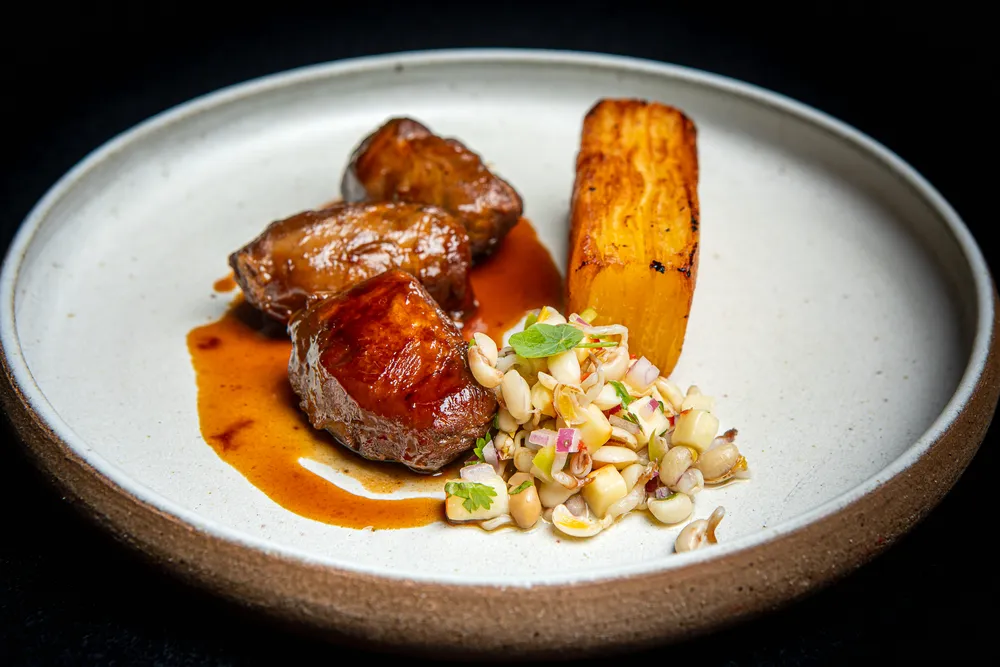Pork Cheek: Complete Guide for a Tender and Flavorful Cut!
Discover everything about the pork cheek, an economical cut, incredibly tender and full of flavor. Learn how to choose, prepare, cook, and check out delicious recipes to make the most of this culinary gem!
Introduction
A pork cheek is a cut still little known by many but gaining more and more prominence in gastronomy. This part of the pig, located in the jaw area, is a true culinary gem, full of collagen and with a melt-in-your-mouth texture when cooked correctly. If you are looking for juicy, flavorful, and economical meat, the pork cheek is the perfect choice! In this article, we will explore everything about this special cut: how to choose the best piece, different preparation methods, tips for perfect cooking, and of course, irresistible recipes to inspire you. Get ready to be enchanted by the tenderness and unparalleled flavor of the pork cheek!

What is Pork Cheek? A Special and Economical Cut
A pork cheek is a muscular cut located on the animal’s face, specifically in the jaw region. It is a muscle highly used during chewing, making it rich in collagen and connective tissue. These characteristics, when slow-cooked, transform into an extremely tender and gelatinous texture that melts in the mouth.
Although considered a “second-rate” cut by many butcher shops, the pork cheek has gained increasing space in haute cuisine, valued by renowned chefs who appreciate its intense flavor and unique texture. Moreover, it is a more economical option compared to nobler cuts, making it an excellent choice for those seeking flavor and savings.
How to Choose Pork Cheek: Tips for a Good Purchase
To ensure success in your recipes with pork cheek, it is essential to choose quality pieces. Here are some tips to help you when buying:
- Appearance: A pork cheek fresh pork cheek should have a vibrant pinkish-red color, with a good amount of interspersed fat (marbling). Avoid pieces that are dull, grayish, or have dark spots.
- Texture: To the touch, the meat should be firm yet slightly soft. Avoid pieces that are too soft or have a slimy texture.
- Aroma: A pork cheek fresh pork cheek should have a mild and characteristic pork aroma. Avoid pieces with a strong, sour, or unpleasant smell.
- Size: As pork cheeks vary in size but generally weigh between 200g and 400g each. Choose the size according to your recipe and the number of servings.
- Origin: Preferably choose local and reliable producers who follow good farming and slaughter practices.
- Ask to have it cleaned: Usually, pork cheeks are sold with skin and a layer of fat. Ask your butcher to clean the pieces by removing excess fat and skin if desired.
How to Prepare Pork Cheek: Cleaning and Cuts
Before cooking, the pork cheek requires simple preparation:
- Cleaning: Wash the pork cheeks under running water to remove any residue. If the butcher did not do this, remove excess fat and skin with a sharp knife, leaving only a thin layer of fat for flavor and juiciness.
- Drying: Thoroughly dry the pieces with paper towels. This helps to seal the meat and get a more golden crust during cooking.
- Cuts (optional): Depending on the recipe, you can leave the pork cheeks whole or cut them into smaller pieces such as cubes or strips. For stews and braises, smaller pieces cook faster and more evenly. For roasting or grilling, whole pieces are better suited.

Seasonings for Pork Cheek: Enhancing Flavor
A pork cheek has a rich and intense flavor that pairs well with a variety of seasonings. Here are some suggestions:
- Salt and black pepper: The base of any good seasoning. Use coarse salt or fleur de sel to enhance the meat’s flavor. Freshly ground black pepper adds a spicy and aromatic touch.
- Garlic: Chopped, crushed, or powdered garlic is a classic seasoning for pork.
- Onion: Chopped onion, slices, or powder complements the flavor of the pork cheek, especially in stews and roasts.
- Fresh herbs: Rosemary, thyme, sage, bay leaf, and marjoram are great options to give an herbal and aromatic touch to the meat.
- Spices: Sweet or smoked paprika, cumin, coriander powder, cloves, and nutmeg can be used to create more complex and interesting flavor combinations.
- Marinades: Marinating the pork cheek for a few hours or overnight helps tenderize the meat and intensify the flavor. Use ingredients like dry red or white wine, orange or lemon juice, balsamic vinegar, soy sauce, honey, mustard, along with the seasonings mentioned above.
Tip: Rub dry seasonings directly on the meat. If using a liquid marinade, make sure the pork cheeks are fully submerged.
Cooking Methods for Pork Cheek: Exploring the Possibilities
A pork cheek is a versatile cut that can be prepared in various ways. The most suitable methods are those involving slow and moist cooking, which help break down collagen and tenderize the meat. Here are some options:
1. Stove-top Stew:
This is one of the most traditional and flavorful methods for preparing pork cheek. Slow cooking in liquid allows the meat to become extremely tender and absorb the flavors of the seasonings and added ingredients.
How to do it:
- Season the pork cheeks to taste.
- In a large, heavy-bottomed pot, heat a drizzle of olive oil or pork lard over medium-high heat.
- Sear the pork cheeks on all sides until golden brown. Remove from the pot and set aside.
- In the same pot, sauté onion, garlic, and other vegetables of your choice (carrot, celery, leek) until soft.
- Return the pork cheeks to the pot.
- Add enough liquid to cover the cheeks halfway (beef broth, vegetable broth, red wine, beer, or a mix of these).
- Add herbs and spices to taste (bay leaf, rosemary, thyme, paprika, etc.).
- Cover the pot, reduce heat to low and cook for about 2 to 3 hours, or until the meat is very tender and falling apart.
- If needed, add more liquid during cooking to prevent drying out.
- You can finish the stew with vegetables like potatoes, parsnips, or pumpkin, adding them in the last 30 minutes of cooking.
2. Oven Roast:
Roasting the pork cheek in the oven is another excellent option, resulting in tender, juicy meat with a golden crust.
How to do it:
- Season the pork cheeks season to taste and, if desired, marinate it for a few hours.
- Preheat the oven to 160°C (low temperature).
- Place the pork cheeks in a roasting pan and drizzle with olive oil.
- Add vegetables of your choice around the meat (onion, garlic, carrot, potato, etc.).
- If desired, add a bit of liquid to the bottom of the pan (beef broth, red wine, or water) to prevent drying.
- Cover the pan with aluminum foil and roast for about 2 to 3 hours, or until the meat is very tender.
- Remove the foil in the last 30 minutes of cooking to brown the meat.
- Let the meat rest for 10 to 15 minutes before slicing or shredding.
3. Pressure Cooker:
The pressure cooker is a great ally to cook the pork cheek more quickly while maintaining tenderness and flavor.
How to do it:
- Season the pork cheeks to taste.
- In a pressure cooker, heat a drizzle of olive oil or pork lard over medium-high heat.
- Sear the pork cheeks sear on all sides until golden brown.
- Add onion, garlic, and other vegetables of your choice (carrot, celery) and sauté for a few minutes.
- Add enough liquid to cover the cheeks halfway (beef broth, vegetable broth, red wine, or water).
- Add herbs and spices to taste.
- Close the pressure cooker and cook on high heat until pressurized.
- Once it reaches pressure, reduce heat to medium-low and cook for about 45 minutes to 1 hour.
- Turn off the heat and let the pressure release naturally.
- Open the cooker, check if the meat is tender, and if necessary, cook for a few more minutes without pressure to reduce the sauce.
4. Grilling:
Grilling the pork cheek is a less common but possible option, especially if you cut it into smaller pieces or thin slices. It is important to marinate the meat beforehand to ensure it is tender and flavorful.
How to do it:
- Season the pork cheeks season to taste and let marinate for at least 2 hours, preferably in the refrigerator.
- Preheat the grill (barbecue or stove grill) over medium-high heat.
- Grill the pork cheeks for about 4 to 6 minutes on each side, or until cooked and browned. Cooking time varies according to meat thickness.
- Let the meat rest a few minutes before slicing and serving.
Pork Cheek Recipe with Red Wine Sauce
To inspire you, here is a delicious recipe of pork cheek slow-cooked with a rich red wine sauce:
Ingredients:
- 4 pork cheeks clean pork cheeks (about 800g to 1kg in total)
- 2 tablespoons olive oil
- 1 large onion, chopped
- 2 medium carrots, chopped
- 2 celery stalks, chopped
- 4 garlic cloves, chopped
- 2 bay leaves
- 1 sprig fresh rosemary
- 1 sprig fresh thyme
- 750ml good quality dry red wine
- 500ml homemade or store-bought beef broth (low sodium)
- Salt and freshly ground black pepper to taste
- 1 tablespoon cold butter (optional, to finish the sauce)
Preparation Method:
- Season the cheeks: Season the pork cheeks with salt and black pepper to taste.
- Sear the cheeks: In a large, heavy-bottomed pot, heat the olive oil over medium-high heat. Sear the pork cheeks on all sides until well browned. Remove the cheeks from the pot and set aside.
- Sauté the vegetables: In the same pot, add the chopped onion, carrot, and celery. Sauté over medium heat for about 10 minutes, or until the vegetables are soft and lightly browned. Add the chopped garlic and sauté for another 1 minute until fragrant.
- Add the herbs and wine: Add the bay leaves, sprig of rosemary, and sprig of thyme to the pot. Pour in the red wine and let it boil for 2 to 3 minutes, scraping the bottom of the pot to loosen the caramelized bits.
- Return the cheeks to the pot: Place the pork cheeks back into the pot.
- Add the broth: Add the beef broth to the pot, enough to cover the cheeks halfway. If needed, add more broth or hot water.
- Cook slowly: Cover the pot, reduce the heat to low, and cook for about 2.5 to 3 hours, or until the pork cheeks are extremely tender and falling apart. Turn the cheeks halfway through cooking to ensure even cooking.
- Finish the sauce: Remove the pork cheeks from the pot and set aside on a platter, covered with aluminum foil to keep warm. If you want a thicker sauce, return the pot to medium-high heat and let the sauce reduce for about 10 to 15 minutes, until reaching the desired consistency. For an even silkier sauce, turn off the heat and add cold butter, stirring gently until incorporated.
- Serve: Slice the pork cheeks or serve whole. Drizzle with the red wine sauce and serve with mashed potatoes, creamy polenta, white rice, or roasted vegetables.
Tips for Perfectly Cooking Pork Cheeks
- Cook slowly: A pork cheek is a cut that benefits from slow, prolonged cooking. This allows the collagen to break down and the meat to become extremely tender.
- Use enough liquid: Make sure there is enough liquid in the pot during cooking to prevent the meat from drying out.
- Don’t be afraid to slightly overcook: It’s better to cook the pork cheek a bit longer than less. If it’s slightly overdone, it will still be tender and falling apart. If undercooked, it will be tough and hard to chew.
- Make the most of the broth: The broth left from cooking the pork cheek is rich in flavor and can be used to make sauces, soups, or risottos.
Image Source: receitas.globo unileverfoodsolutions







